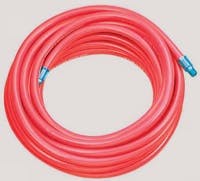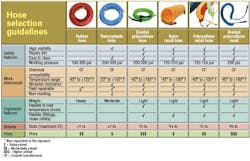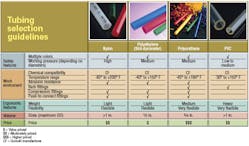By Fred Mowczan,
Coilhose Pneumatics
Although similar, hose is different from tubing. Hose is generally measured by inside diameter, while tubing is measured by outside diameter. Hose is made of three or more layers, a tube, support braids, and a cover, with the exception of most one-part recoil hose. Tubing is often a single layered tube. Hose is mobile, often being dragged through a work area, while tubing is often stationary within a machine frame.
In the past, the air hose of choice was the old heavy, robust, red rubber air hose. Presently, red rubber is still one of the most popular choices, due to customer familiarity — but in many cases it may not be the best choice. With the development of new compounds, extrusion and braiding technologies, and advances in hose fittings, there are more options than ever before.
Like hose, flexible tubing choices have expanded, due to advancements in materials and extrusion technologies. Added flexibility, more colors, greater chemical compatibility, and added strength are just a few of the improvements to tubing. Plumbing air systems in tighter, more challenging environs are on the horizon for the machine assembler.
Safety concerns
Consider the following criteria to choose the proper hose and tubing:
- The visibility of an air hose is critical. An application may cause the air hose to lie on the floor for the majority of its life. Highly visible colors are essential, as is the ability to clean the hose. If a hose retains dirt, it blends into the surroundings, becoming a tripping hazard. In tubing applications, visibility and color-coding is very important for installation and trouble shooting.
- Accidental disconnections cause hoses to fly dangerously around the workplace. Although a function of the attached fittings, hose assemblies should have the components on board to prevent these unsafe events.
- Over pressurization will cause hoses and tubes to rupture. Working pressures of the application should match the working pressures found on the lay-line of the specified air hose.
The work environment
The location where the hose, tubing, and fittings are used is an important factor in selection. Are hoses suspended from the ceiling in a clean room of a computer manufacturing facility, lying on the cement floor of a factory, or used outside on a construction site? These questions must be addressed when reviewing the characteristics of the hose and or tubing selected.
Chemical compatibility looms large in determining the type of materials for the hose, tubing, and fittings. How the selected components will react to oils, chemical, gases, and even sunlight must be investigated. Due to a wide range of variables, consulting the manufacturer is often the best course of action. The temperature of the air traveling through the components and the environment they are being used in is critical. Hose and tubing flexibility and pressure ratings are affected by temperature, so this factor needs to be considered in the selection process. The data generally can be obtained through manufacturers' catalogs.
Durability is measured by how the hose or tubing resists abrasion and wear of the day-to-day conditions of the existing application. The durability of the component is often compromized when important considerations of the applications are overlooked. When addressing an item's durability in this article, we assume all considerations of the application have been addressed.
When a hose fails, users will often prefer to repair rather than replace a failed hose, to save time. For that reason, hoses that come standard with field-repairable ends are a great value. Although the inexpensive crimped air hose assembly is prevalent in the market, easy-to-repair air hoses are becoming more popular.
Ends or fittings for tubing are fieldrepairable. Tubing uses barb, compression, and push-to-connect type fittings. The hardness of the tubing material, measured is durometers, dictates the type of fitting to be used. A softer (lower durometer) tube can accept a barb without splitting. This method often restricts flow within the application. The barbs incerted into the softer tubing reduce the size of the flow path of air through the tube. Harder tubes work in conjunction with compression and push-to-connect fittings, which grip the tube from the outside. This combination is quickly becoming the standard. For this reason, the outside diameter of the tubing is a critical dimension.
Other issues
Ergonomic concerns are very important when selecting the right air hose. Carpal tunnel, back health and overall productivity are directly affected by the choice made.
Heavier air hose is not necessarily stronger air hose. With the advancements in compounds and extrusion, the weight of air hose has dramatically decreased without sacrificing the structural integrity of the hose. At one time dragging 50 ft of air hose around a work area took a great deal of strength, but new materials result in hoses that take less effort than ever before by offering hose with decreased weight, less kinking, and greater abrasion resistance.
The flexibility of hose and fittings has benefited due to the fore-mentioned advancements. Flexible hose, tight bending strain relief fittings, and ball swivel type hose ends have increased the mobility at the tool end of the hose. The flexibility of tubing, like hose, has also improved. Plumbing air systems in tighter spaces is now possible. Pneumatic control panels seem to be more complex and smaller in size.
The style of the hose used, straight or recoiled, is determined by the application. Suspended tools or end effectors with vertical travel often utilize recoil hoses. Recoil hoses work well for short, unobstructed runs while used in the horizontal plane. Recoil hoses' easy stowage while at rest is one of their most desired features. For longer runs where the operator can expect many obstacles, straight hoses are the product of choice.
The volume of air (scfm) required for the job determines size of the inside diameter of the hose and/or tubing, the end fittings used, and the overall length of the assembly.
Price, although a factor, should not be the driving force behind your choice. Ignoring quality, life expectancy, suitability of the selection and time lost for repairs or replacement can be disastrous.
The STAMPED way
There is an acronym used by several hose manufacturers and distributors to assist them in selecting a hose, STAMPED.
S: Size of the hose or tubing, in length required
T: Temperature demands of the application (minimum and maximum)
A: Application needs including flexibility, weight, climate, external conditions, color, and any regulatory requirements
M: Media inside and outside the hose and or tubing which will be used (chemical compatibility)
P: Pressure of the working system
E: End fittings required. For hose crimp: re-useable, metric, standard, etc. For tubing: barb, compression, or push to connect.
D: Diameter of the hose or tubing. Although both measurements are important, hose is classified by inside diameter, whereas tubing is classified by outside diameter.
When thinking about expensive air system components, such as compressors and dryers, the "lowly" air hose is often taken for granted. But designers and users should consider that the system is only as good as its weakest link, and — with some forethought — an appropriately specified air hose can make a big difference.
However, advancements in technology concerning air hose and tubing, makes them more of an engineered product. Reviewing the application's needs allows for the best choice, resulting in a long-lasting, money saving, and highly productive purchase.
|
Do you have an automation success story? |
Fred Mowczan is the technical sales manager for Coilhose Pneumatics, located in East Brunswick, N.J. Contact him at (732) 390-8480 or at [email protected]




